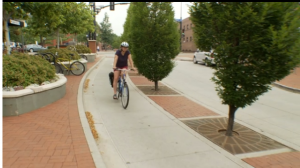
It's called the "built environment" and if you're a public health whiz, you know exactly what that means. If you don't, Dr. Richard Jackson, Chair of UCLA's Environmental Health Sciences Department believes it's critical you do.
"By the built environment," he explains, "we mean everything around us that was changed by human activity, homes, building, streets that we're surrounded by." In other words, it's where we live our lives, work, or go to school. When the car came along, the built environment seemed to build up on its own without any thought to health impacts. "We've made it hard to walk," he says. "We've engineered physical activity out of our daily lives."
Jackson hosts a new documentary series, Designing Healthy Communities, that debuts tonight in Los Angeles and rolls out across the country over the next several weeks on PBS. In the series he makes the case that the built environment itself is so unhealthy, it causes people to be unhealthy. Among other things, he links this unhealthy built environment to two of the greatest health disorders of our day, obesity and diabetes.
But the built environment does not need to cause so much harm. The concept of the built environment, Jackson says, is both "relatively new and desperately old." In the 1800s people working in urban planning overlapped with people working in public health, he says. Two of the seven founders of the American Public Health Association were urban planners. But then urban planning as a component of health seemed to fall by the wayside after the advent of the automobile which led to suburban sprawl, abandoned and impoverished inner cities, and isolation.
In Part I of his series, Jackson calls for the "retrofitting of suburbia."